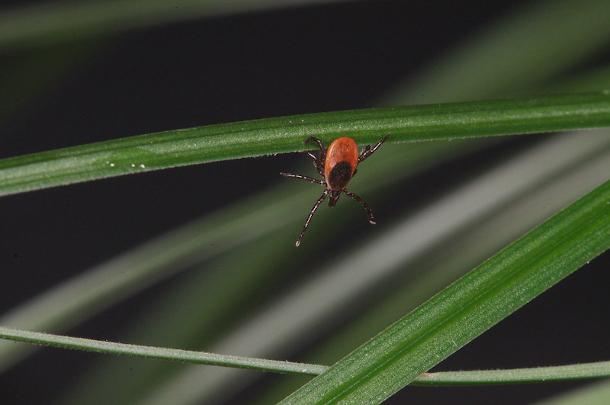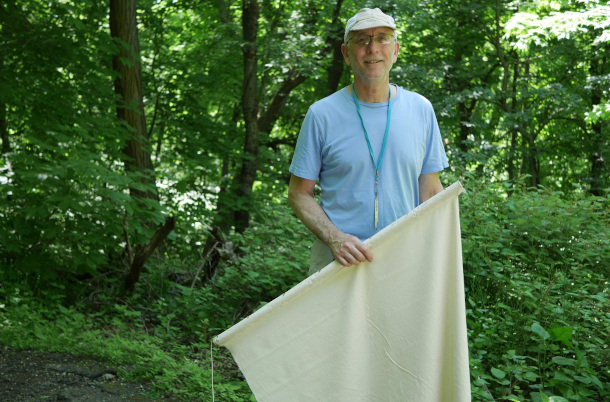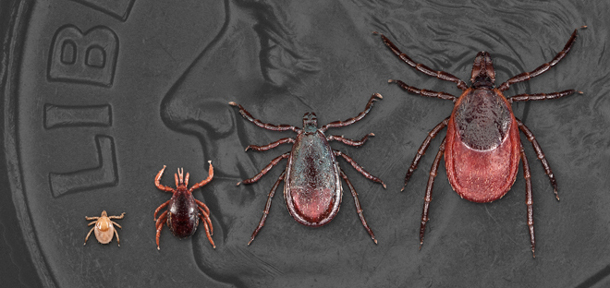Lyme Disease Risk is High in City Parks, Too
Air Date: Week of June 12, 2020

A female blacklegged tick reaches out her forelegs in search of a blood meal. (Photo: James L. Occi / Armed Forces Pest Management Board, Flickr CC BY-NC-ND 2.0)
People in cities have been relying on parks for a dose of fresh air during the pandemic, but lurking in the leaf litter and elsewhere in the park might be the tiny ticks infected with the bacteria that causes Lyme disease. Kara Holsopple from The Allegheny Front has the story.
Transcript
CURWOOD: You might be thinking it’s perfectly safe to head out to a park to get some fresh air during the pandemic but be careful. Lurking in the leaf litter and elsewhere in the park might be the tiny ticks that carry Lyme disease. Kara Holsopple from The Allegheny Front has the story.
HOLSOPPLE: Thomas Simmons and his biology students from Indiana University of Pennsylvania, collected black legged tick samples from random sites in four of the large Pittsburgh parks in 2015 and 2016, including Schenely Park
SIMMONS: This is Prospect Hill, a hotspot.
HOLSOPPLE: The trail is shaded by trees on either side and Simmons drags a one meter square of white heavy flannel material along the edge of the path.
SIMMONS: I'm going to veer off a little bit into the woods, get off of the pavement and the gravel here.
HOLSOPPLE: The idea is that the ticks stick to the flannel which is about the size of a beach towel as it's pulled along the ground. In a few weeks it will be the peak of nymphs season that's the stage between the larval tick and an adult. And a bite from a nymph is how most cases of Lyme disease are contracted someone sets.
SIMMONS: They're attracted to vibrations, heat, shadows. I mean they are well equipped to find the host. It’s like a heat seeking erected really.
HOLSOPPLE: After about 10 steps, he carefully checks the fabric.
SIMMONS: Oh, there's one right there. Oh, my goodness. So take a look that's small.
HOLSOPPLE: It's the size of a poppy seed. Simmons and his team also set up stations within the woods where nymphs prefer the cooler moist habitat. The study about infected ticks in the parks was published online in the Journal of Medical Entomology last September.
So what did you find?

Thomas Simmons and his team used flannel “drags” to sweep over vegetation at the edge of trails and wooded areas to find and collect blacklegged ticks for the study. (Photo: Kara Holsopple / The Allegheny Front)
SIMMONS: So overall, for all the parks 50% of the adult ticks were infected. And 20% of the nymphs, we call that infection prevalence and those infection prevalence’s are characteristic of a region which is highly endemic for Lyme disease, which Western Pennsylvania now is and those present infection rates are comparable to what has historically and presently is found in Southeastern New York where we typically use that as kind of I don't say worst case scenario, but but as a good comparison to determine how bad I can use the word bad. But how much concern there is or how high the Lyme disease risk is probably a better way to put it.
HOLSOPPLE: Though the risk is high?
SIMMONS: So the risk is high. Also, not only is it important in terms of what percent of the ticks are infected, but it's important to know what the density the abundance of the density of the ticks are. Because what really determines Lyme disease risk is the the numbers of infected ticks, and the density of infected nymphs and the density of infected adults in these parks is also comparable to the East Coast. I should also note that not every infected tick infects. So that's important to realize that these are really high rates 50% of adults are infected, you might think, Oh my goodness. 50% if I'm bitten by a tick, adult tick, I have 50 % chance of being affected or if I'm bitten by a nymph, I have 20% chance of being affected. No, not every infected tick.
HOLSOPPLE: Simmons estimates the tick density in Pittsburgh parks is about one tick per two square yards. He says the study findings certainly don't mean people shouldn't use the parks, but just take precautions. his advice to avoid being bitten by a tick is to stay to the center of trails. Wear light colored clothing so you can see the ticks clinging to your clothes and tuck long pants into socks. You can also treat your clothing with a chemical insecticide or essential oils. When you go home, toss your clothes into a hot dryer for 10 minutes.

From left, the larvae, nymph, adult male and adult female forms of the blacklegged or deer tick, which can carry Lyme disease. (Photo: CDC)
SIMMONS: That day, that night, definitely take a shower and check every part of your body and then some.
HOLSOPPLE: Simon says a nympho feel like a little bump or pimple. So what is the significance of what you found for Pittsburgh and also for urban areas where they have you know, Parks like this.
SIMMONS: So I think the take home message is that when you use a park By all means, do this is a good thing during this pandemic, especially, you know, you got to get out and getting exercise anytime a year is really important. And it's just, it's healthy. It's it's, it's just good for you. However, like anything else, there's risks, there's risks of crossing a street, there's risks of riding a bicycle. So not only is it useful, important for any Pittsburghers to know that there is Lyme disease risk, and they should take precautions as they should in rural suburban parks and in their backyards. But it's sort of a wake up call and and emphasizes the importance of looking at tick borne disease risk of Lyme disease risk in city parks in any place in the country.
HOLSOPPLE: What can be done by parks or people who manage these types of spaces to manage ticks? Is there anything that you can do to minimize tick exposure for for people who are using the parks?
SIMMONS: Basically, ticks and Lyme disease and other tick borne diseases? They're here to stay? We do not have a vaccine yet. So it's all about prevention. But also parks can take preventative measures, and that's basically education, Lyme disease awareness signs. Just like now with COVID-19, what do you see? Social distancing signs. We should be doing the same thing for tic signs in areas that I think well, I think every entrance should be posted, but at the minimum areas that have a high numbers like here. Also, and I think it's at least my experience going through all these parks is that the trails that most people use are well managed. Right, the trail we are on doesn't have vegetation and grass growing out into it. Right, we're we're walking on part dirt gravel as you saw, you could still pick up nymphs there, but we'd pick up a lot more if I was dragging through the leaf litter believe me. As long should be kept short, trails should be kept clear and the edges should be manicured.
HOLSOPPLE: Thomas Simmons is a biology professor at Indiana University of Pennsylvania. For Living on Earth I'm Kara Holsopple.
CURWOOD: Kara Holsopple’s story comes to us courtesy of The Allegheny Front.
Links
The story on The Allegheny Front | “Lyme Disease Risk Is High in City Parks, Too”
CDC | Learn more about ticks and tickborne diseases
Lyme disease and climate change
Listen to our story on the idea of using guinea fowl for backyard tick control
Living on Earth wants to hear from you!
Living on Earth
62 Calef Highway, Suite 212
Lee, NH 03861
Telephone: 617-287-4121
E-mail: comments@loe.org
Newsletter [Click here]
Donate to Living on Earth!
Living on Earth is an independent media program and relies entirely on contributions from listeners and institutions supporting public service. Please donate now to preserve an independent environmental voice.
NewsletterLiving on Earth offers a weekly delivery of the show's rundown to your mailbox. Sign up for our newsletter today!
 Sailors For The Sea: Be the change you want to sea.
Sailors For The Sea: Be the change you want to sea.
 The Grantham Foundation for the Protection of the Environment: Committed to protecting and improving the health of the global environment.
The Grantham Foundation for the Protection of the Environment: Committed to protecting and improving the health of the global environment.
 Contribute to Living on Earth and receive, as our gift to you, an archival print of one of Mark Seth Lender's extraordinary wildlife photographs. Follow the link to see Mark's current collection of photographs.
Contribute to Living on Earth and receive, as our gift to you, an archival print of one of Mark Seth Lender's extraordinary wildlife photographs. Follow the link to see Mark's current collection of photographs.
 Buy a signed copy of Mark Seth Lender's book Smeagull the Seagull & support Living on Earth
Buy a signed copy of Mark Seth Lender's book Smeagull the Seagull & support Living on Earth

